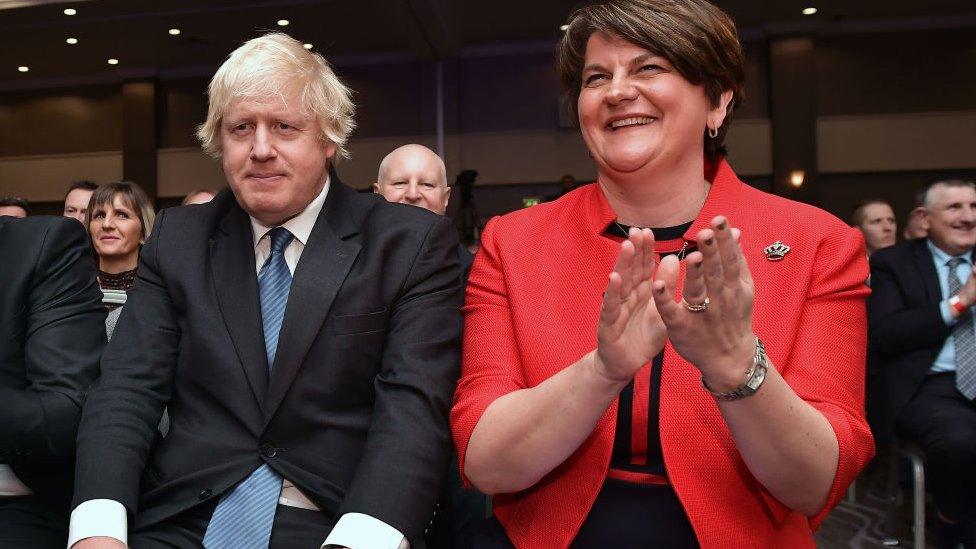Leo Varadkar: Key moments for Brexit taoiseach
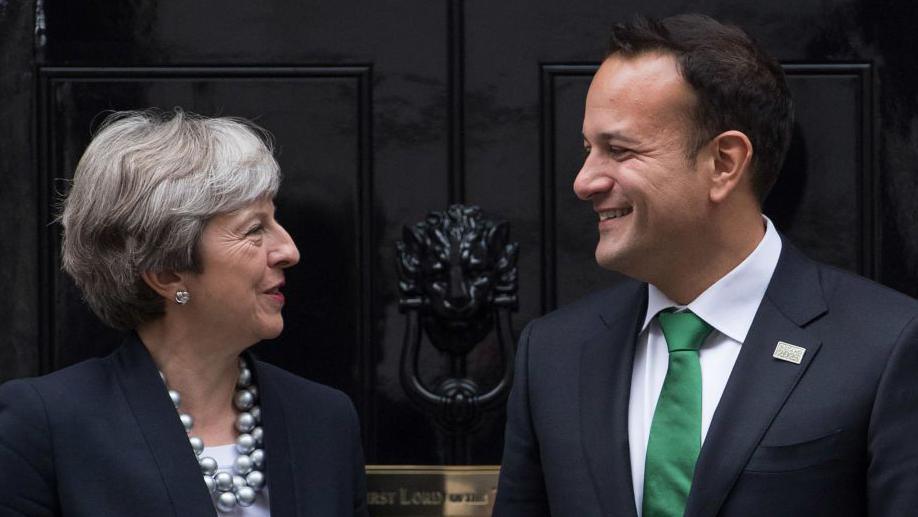
The former British Prime Minister Theresa May pictured with Leo Varadkar in Downing Street in 2017
- Published
Leo Varadkar was taoiseach during the most intense phase of Brexit, when the Irish border was central to negotiations.
In January 2017, the then UK Prime Minister Theresa May said Brexit would mean the UK leaving the single market and the customs union.
That had immediate implications for Ireland, raising the prospect that it would have to harden its border with Northern Ireland.
The Irish government quickly decided that would be a bad idea for economic, political and security reasons.
Its Brexit bottom line was that there could be no hard border and Ireland’s place in the EU should be undisturbed.
It fell to Leo Varadkar to pursue that policy.
July 2017
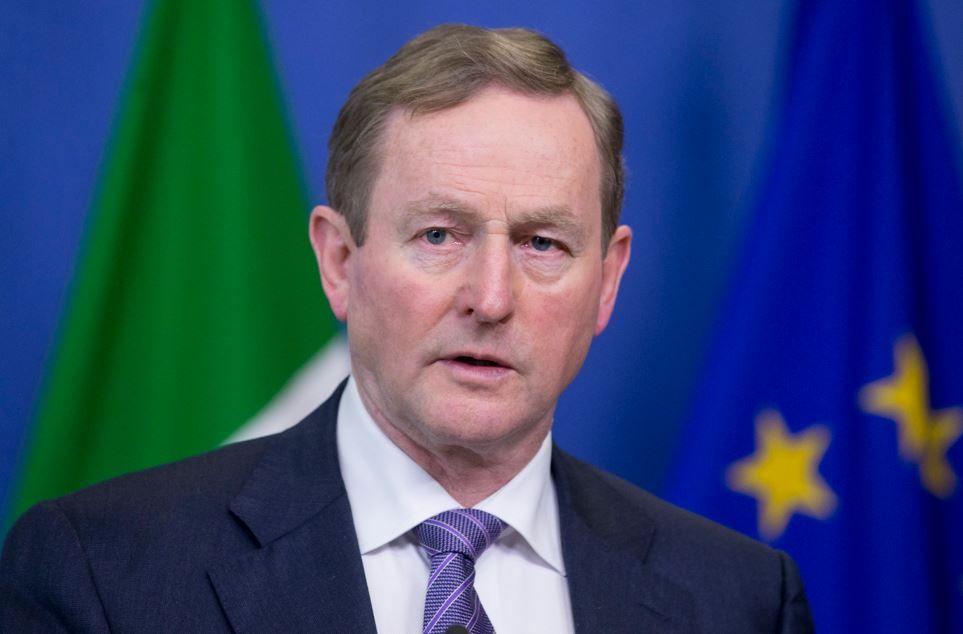
Enda Kenny had a different style to Leo Varakar when he was leader
There is a perception among some Brexit supporters that Ireland’s approach hardened when Mr Varadkar became taoiseach and that his predecessor Enda Kenny would have been a friendlier, more accommodating partner for the UK.
However Ireland’s key Brexit policy had been set months before Mr Varadkar took the top job.
The EU’s negotiating guidelines of April 2017 had the avoidance of a hard border in Ireland as one of its three priorities.
There was certainly a stylistic contrast between Mr Kenny and Mr Varadkar. The new taoiseach could be brusque, even blunt.
A month after becoming taoiseach he made clear his exasperation with some of the ideas for the border coming from Brexit supporters.
"What we’re not going to do is to design a border for the Brexiteers because they’re the ones who want a border," he said.
"It’s up to them to say what it is, say how it would work and first of all convince their own people, their own voters that this is actually a good idea.
"As far as this government is concerned there shouldn’t be an economic border. We don’t want one."
This robust defence of Ireland’s interest set the tone for his approach over the next few years.
December 2017
Throughout the second half of 2017 EU and UK negotiators laboured to find a way to square Theresa May’s hard Brexit with a soft Irish border.
An interim agreement called the Joint Report saw the UK implicitly concede that an Irish Sea border, between NI and GB, could be a solution.
The Joint Report laid out three possibilities:
• The border issue could be solved in the context of an overall trade deal
• There could be technological and administrative solutions
• Northern Ireland could continue to follow some rules of the EU internal market and the customs union - this was known as the backstop
Five steps that led to an Irish Sea border
- Published23 December 2020
Enda Kenny: From bust to boom to Brexit
- Published17 May 2017
For Mr Varadkar this was effectively mission accomplished with the UK signing up to a text which ruled out a hard border.
‘We have achieved all we set out to achieve in phase one of these negotiations,’ he said.
‘We have the assurances and guarantees we need from the United Kingdom and support for them from the European Union.’
He went on to paraphrase Winston Churchill describing the agreement as ‘not the end, but it is the end of the beginning.’
October 2018
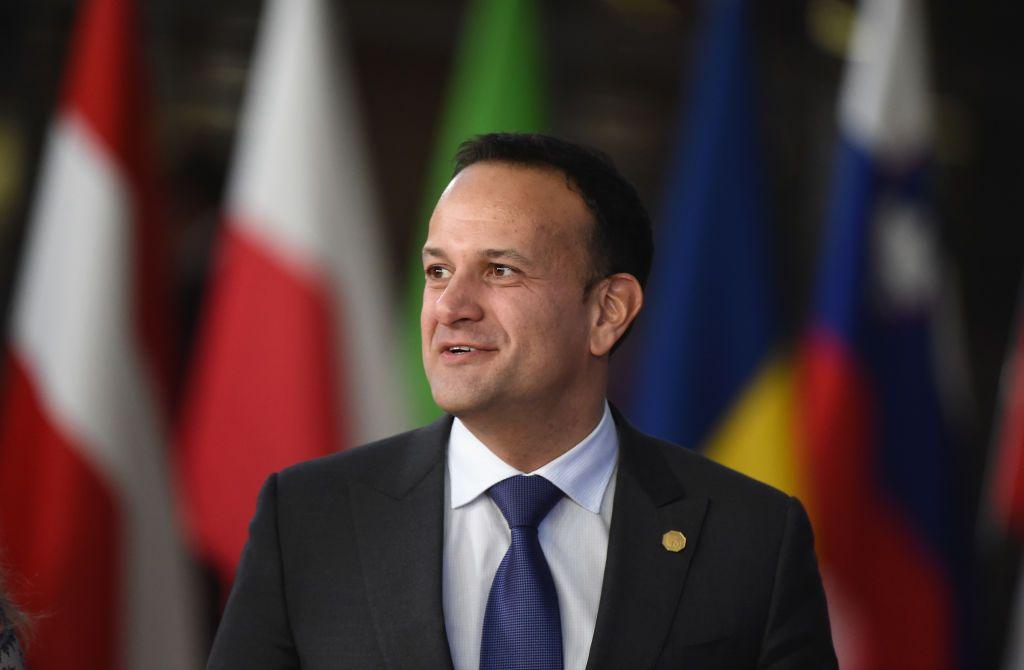
Leo Varadkar pictured in 2018
Mr Varadkar was right to suggest that the Brexit negotiations would not be concluded quickly.
Throughout 2018 it became clear that Theresa May had signed up to a deal that would not win majority support in the House of Commons.
Most importantly the DUP, which was keeping her party in power, was opposed to the backstop.
There was an interminable series of summits and negotiations in an attempt to finesse the deal.
At a meeting of EU leaders in October 2018 Mr Varadkar sought to impress on his peers just how important it was to stand firm on the border issue.
He showed them a story from that day’s Irish Times about the IRA bombing of a customs post in 1972 in which nine people were killed.
This provoked outrage among unionists who suggested he was using the threat of violence to advance his political agenda.
Mr Varadkar said this was never his intention later explaining: ‘I have never used a threat of violence in politics.
‘What I did was express concerns at the time that were held by the Chief Constable and the Garda Commissioner, that the reestablishment of border posts between north and south could lead to violence.
"But there’s a very big difference I think, between warning or expressing concern about violence, and threatening it, and I certainly didn’t do that.”
But this episode became emblematic of the low opinion many unionists had of his approach to Brexit.
Brexit: I have never used threats of violence, says Irish PM
October 2019
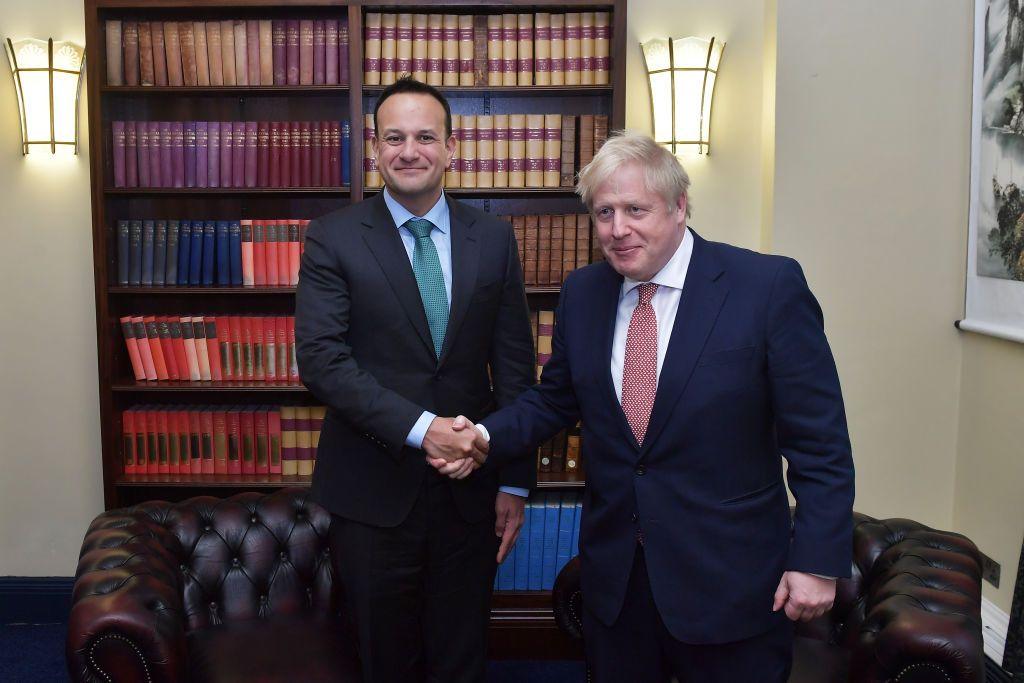
Leo Varadkar had a new UK counterpart in July 2019 when Boris Johnson replaced Theresa May
Mr Varadkar had a new UK counterpart in July 2019 when Boris Johnson replaced Theresa May.
He promised to ditch the backstop but by October, he was proposing an "all-island regulatory zone" which would effectively keep Northern Ireland in the EU's single market for agriculture, food and all manufactured goods.
However, the Irish government and the EU were not convinced as the plan would have potentially meant a new customs border in Ireland.
They were also concerned an up-front veto for the DUP could prevent the "all-island regulatory zone" from ever materialising.
But then came a decisive meeting with Mr Varadkar at Thornton Manor on Merseyside.
This would prove to be the engagement which unlocked a deal that would finally be approved by the UK Parliament.
Mr Johnson accepted that there would be a border in the Irish Sea while Mr Varadkar conceded that Stormont would need to have some democratic oversight.
A joint statement said: "Both continue to believe that a deal is in everybody’s interest. They agreed that they could see a pathway to a possible deal."
Just a week later, the UK and EU had agreed the Northern Ireland protocol.
An amended version of the protocol, the Windsor Framework, now governs NI’s post-Brexit trading arrangements.
March 2024
As Mr Varadkar announced his resignation on Wednesday he counted his approach to Brexit among his key achievements.
He referenced Ireland’s original objectives saying: "We prevented a hard border between North and South and protected our place in Europe."
He also suggested that with the DUP’s return to government a period of difficult relations, east-west as well as north-south, was now beginning to heal.
"The institutions of the Good Friday Agreement are working again, and our trading relationship with the United Kingdom, in the post-Brexit era, is settled and stable," he concluded.
- Published17 May 2017
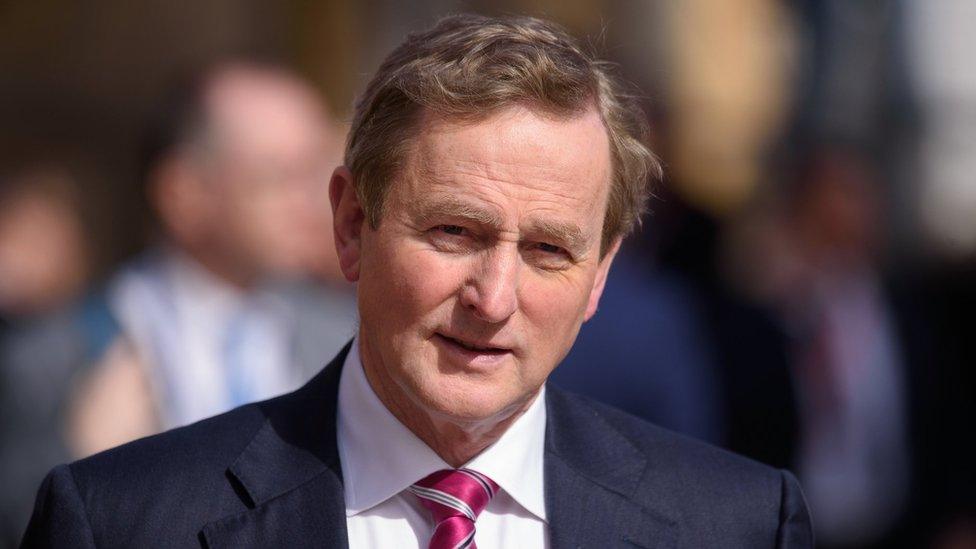
- Published28 July 2017
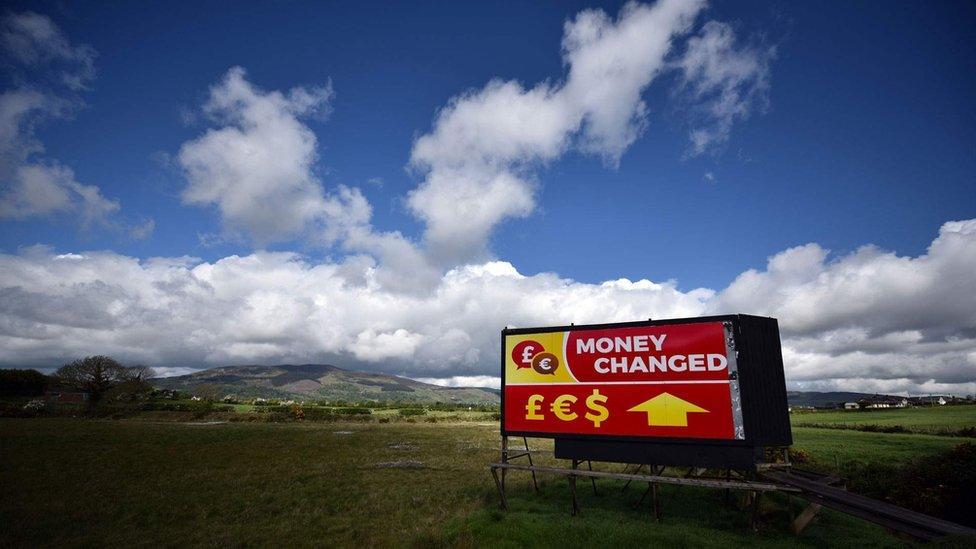
What is the Windsor Framework?
- Published2 February 2024
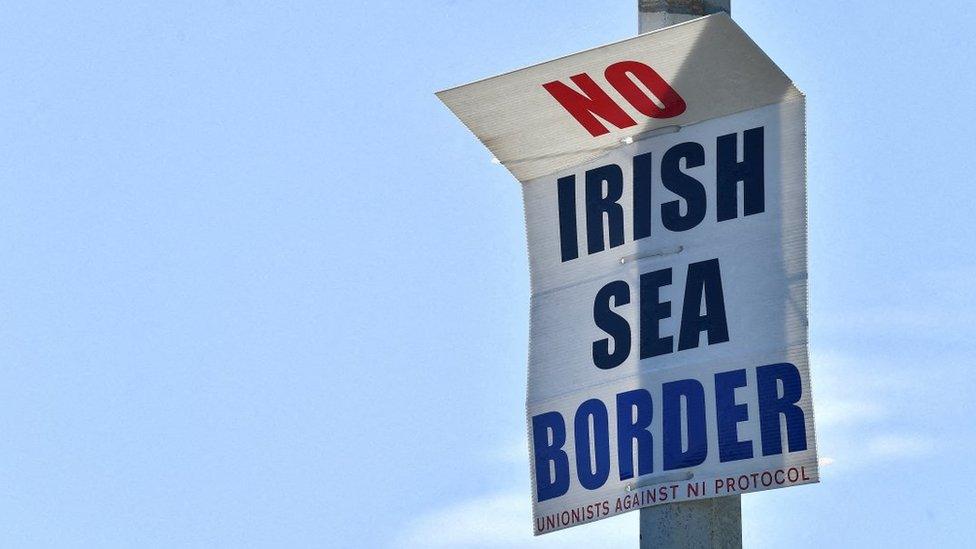
- Published7 July 2022
